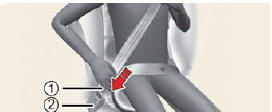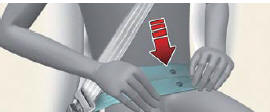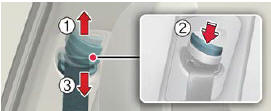Kia Sportage: Seat belt - Driver's 3-point system with emergency locking retractor
The following explains how to fasten and adjust the driver's seat belt.
Fastening the your seat belt:
 Pull it out of the retractor
and insert
the metal tab (1) into the buckle (2).
Pull it out of the retractor
and insert
the metal tab (1) into the buckle (2).There will be an audible "click" when the tab locks into the buckle.

WARNING
You should place the lap belt portion as low as possible and snugly across your hips. If the lap belt is located too high on your waist, it may increase the chance of injury in the event of a collision.
The arm closest to the seat belt buckle should be over the belt while the other arm should be under the belt as shown in the illustration. Never wear the seat belt under the arm closest to the door.
The seat belt automatically adjusts to the proper length only after the lap belt portion is adjusted manually so that it fits snugly around your hips. If you lean forward in a slow, easy motion, the belt will extend and let you move around. If there is a sudden stop or impact, however, the belt will lock into position. It will also lock if you try to lean forward too quickly.
NOTICE
If you are not able to pull out the seat belt from the retractor, firmly pull the belt out and release it. Then you will be able to pull the belt out smoothly.
Adjusting the height of shoulder belt
You can adjust the height of the shoulder belt anchor to one of the 4 positions for maximum comfort and safety.
 The height of
the adjusting seat belt
should not be too close to your neck.
The height of
the adjusting seat belt
should not be too close to your neck.
The shoulder portion should be adjusted so that it lies across your chest and midway over your shoulder near the door and not your neck.
To adjust the height of the seat belt anchor, lower or raise the height adjuster into an appropriate position.
- To raise the height adjuster, pull it up (1).
- To lower it, push it down (3) while pressing the height adjuster button (2).
Release the button to lock the anchor into position. Try sliding the height adjuster to make sure that it has locked into position.
Improperly positioned seat belts can cause serious injuries in an accident.
WARNING
Shoulder belt positioning
Verify the shoulder belt anchor is locked into position at the appropriate height.
Never position the shoulder belt across your neck or face. Improperly positioned seat belts can cause serious injuries in an accident.
WARNING
Seat belt replacement
Replace your seat belts after being in an accident. Failure to replace seat belts after an accident could leave you with damaged seat belts that will not provide protection in the event of another collision.
READ NEXT:
 Seat belts - Front passenger and rear seat 3-point system with combination locking retractor
Seat belts - Front passenger and rear seat 3-point system with combination locking retractor
The following explains how to fasten the
passenger's and rear seat belts.
Fastening your seat belt:
Combination retractor type seat belts
are installed in the rear seat positions to
help acco
 Pre-tensioner seat belt
Pre-tensioner seat belt
Your vehicle is equipped with driver's
and front passenger's pre-tensioner seat
belts (retractor pre-tensioner and EFD
(Emergency Fastening Device)).
The pre-tensioner
seat belts may be
 Seat belt precautions
Seat belt precautions
Take the following precautions when
using seat belts.
Infant or small child
All 50 states have child restraint laws.
You should be aware of the specific
requirements in your state. Child and/or
SEE MORE:
 Rear Door
Rear Door
Components and Components Location
Components
Rear door trim
Rear door inside handle cap
Rear door belt inside weatherstrip
Rear door trim seal
Rear door module
Rear door panel
Rear door belt weatherstrip
Rear door frame garnish
Rear door body side weatherstrip
Rear do
 Front Bumper | Rear Bumper
Front Bumper | Rear Bumper
Components and Components Location
Components
Front bumper cover
Front bumper side bracket [LH]
Front bumper side bracket [RH]
Repair procedures
Replacement
CAUTION
Put on gloves to protect your hands.
Use a plastic panel removal tool to remove inter
Content
- Home
- Kia Sportage - Fifth generation (NQ5) - (2022-2025) - Owner's Manual
- Kia Sportage - Second generation (JEKM) (2005-2015) - Body Workshop Manual
- Kia Sportage Third generation (SL) - (2011-2016) - Service and Repair Manual
- Sitemap
- Top articles